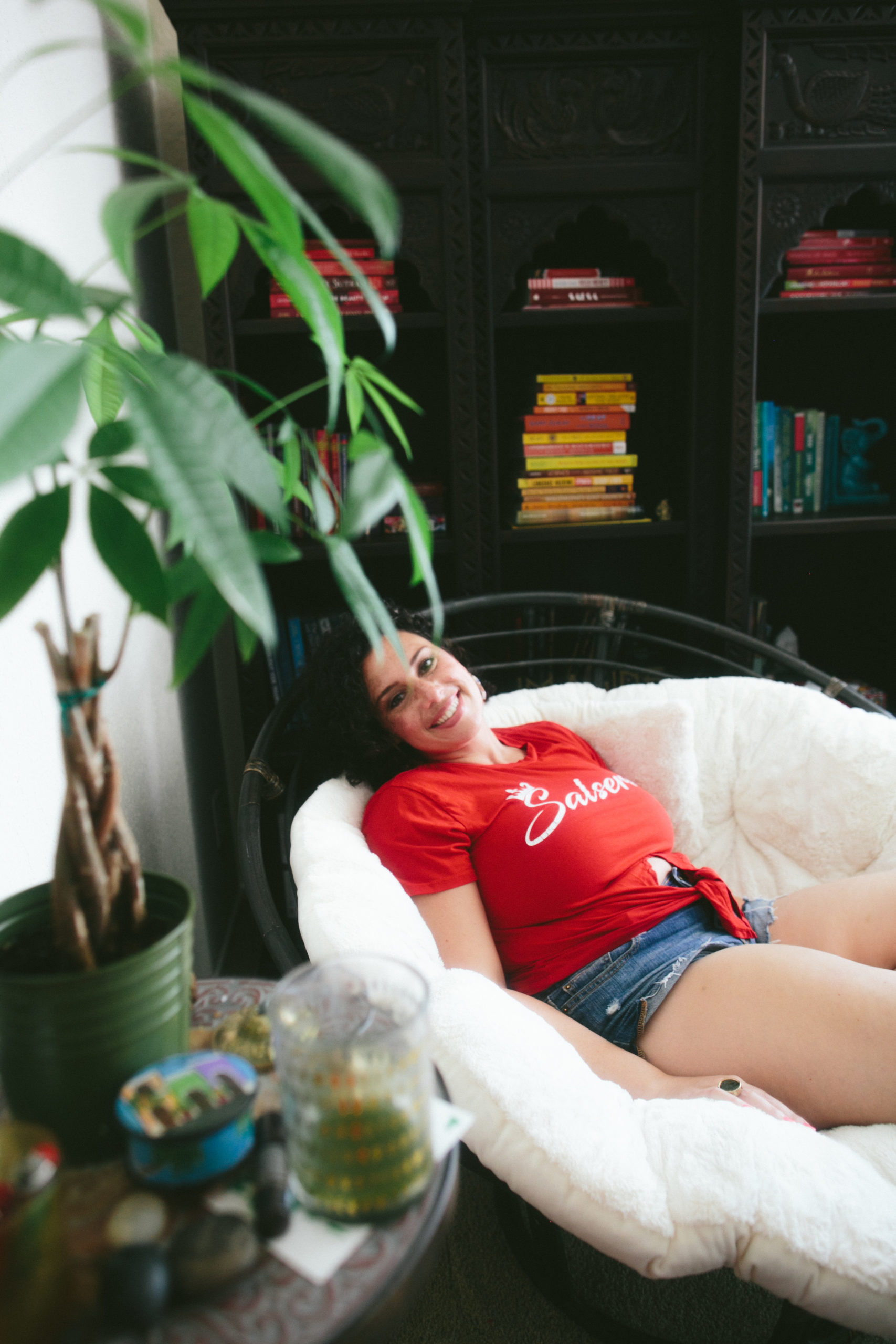THE WILD SOUL MOVEMENT
embodiment bibleIt’s Time to live a more sensual, embodied life.
It’s time to develop more trust and love for your body. To connect to the power, joy, truth, wisdom, and purpose that has always been inside you.
The reasons WHY these things matter and the benefits of pursuing them are endless…
What is embodiment? You may ask.
There are six aspects of EMBODIMENT that we’ll explore in the bible here. Four are broader concepts while two are core practices from Wild Soul Movement.
This is meant to be a resource for you to start or refresh your EMBODIMENT journey.
Don’t worry, I won’t ask you to leave your mind behind…
I’ll show you. Let’s get started.
[flipboxes id=”17903″]

Your body is a genius.
It’s your reason for being here on earth.
It’s what connects you directly to your soul and the Divine.
It’s the only home you’re guaranteed.
It’s a living, breathing, hyper-creative source of wonder, awe, and miracles.
It’s a work of art. It’s a healing machine.
It’s a trusty guide. It’s imperfect and unique.
It’s a whole experience, one a lot of women take for granted, treat as a burden or sadly, even hate.
And that’s why you’re here.
The relationship you’re meant to have with your body is based in love, trust, knowledge, acceptance, and respect.
Your body gives you the experience of “the recurring joy of living” as the opening poem from Rumi says.
If you are not experiencing these things right now, there’s no need to judge or blame yourself – it’s likely no one taught you how.
And believe me, if you’re a woman living in the 21st century, chances are you need someone to teach you!
After working with thousands of women in and around their bodies since 2008 in a few different professional contexts, I firmly believe that embodiment is the absolute most critical key to healing and sustainable wellbeing.
Our greatest resource is Within us.

“Tell me the truth,” I asked love,
“What are you?”
“I am the everlasting life,” love said,
“I am the recurring joy of living.”
-Rumi
I wrote the first edition of this toward the end of October 2019. At that time I was reflecting on the immense amount of challenges, complexity, and volatility in the world.
I revised it in September of 2020 – when the collision of an upcoming US Presidential election, the ongoing COVID-19 pandemic, and the Black Lives Matter Movement made the world feel even more challenging, complex, and volatile than I could have imagined not even a year prior.
It was clear that our capacities were being stretched on every level – physical, mental, emotional, and spiritual.
But since the Earth hadn’t given out on us yet, I trusted that we must be meant to be here, working it out and getting through it.
The questions I was asking in 2019, remained relevant in 2020:
How do we thrive? How do we feel free and find joy?
How do we avoid being mired in hustling, struggling, or just getting by?
I believe in paradox and that we can hold many things at once. Even amidst frustration, stress, feeling overwhelmed, fears, doubts, or “not being where we want to be” – which we can maintain passion, hunger, enthusiasm, and excitement for living?”
You can’t find the answers to these questions in your mind or in a text. The answers to life’s deepest questions always have, and always will live in the body.
The answers to life’s deepest questions always have, and always will, live in the body.
WHAT IS EMBODIMENT?
Let’s break down the word – “em” comes from the French assimilation “en”, meaning, “in, into” and also, “put in or into, bring to a certain state.” We know what body means, and “ment” denotes an action or resulting state.
Based on that, embodiment means the state of being in the body.
So embodiment work is the practice of being in, present with, and connecting to your body.
Now technically, we’re all always embodied, we can’t actually leave our bodies or we’d be dead. It’s not that literal…
The embodiment meaning I’m referring to is about allowing your soul to fully inhabit your body. That is something a lot of people don’t know how to do.
Embodiment is a way of being with yourself, it’s easily accessible self-care. It’s one of the most natural ways of being that most people forget about way too often.
Embodiment is available to anyone, regardless of their body’s current size, shape, condition, ability, or health.

Scope of Practice Note: A lot of embodiment work and practices have roots in somatic therapies and can be very healing. However, I am not a therapist and everything in this guide assumes your nervous system is in a regulated enough state where you’re not in any activated trauma spell and you’re in an overall mental and emotional state where choices are available to you. If you know you have unaddressed or unprocessed trauma of any kind or are currently dealing with a diagnosed anxiety, depression, or psychological disorder, the concepts and practices may not be as effective or appropriate for you right now. If you’re unsure, please consult a professional.
the meaning of embodiment isn’t something we’re taught.
You don’t learn this growing up, because you’re too busy learning to pick your body apart in an effort to get it to be pleasing, desirable, or perform – likely for someone else’s benefit or approval.
It’s just how most women are socialized. This orientation is practically in the air you breathe.
The specifics of the beliefs and inner dialogue about the body may vary, but the result is the same – living disconnected from your body, which also means disconnected from your soul.
This looks like having no idea how magical and wise you truly are and lacking tools, practices, and skills to tap into your innate power, magic, divinity, and wisdom.
Since nothing exists in isolation, these beliefs about the body trickle into other life areas, too.
Lacking a connection to your body can also translate into lacking:
- Intimacy, closeness, and support in your relationships,
- Fulfillment in your role as a parent or in your career,
- Health, vitality, vibrancy, passion, joy, meaning, purpose, or fun in your life as a whole.
In 2013, when I shifted my work entirely towards helping women get out of their heads and into their bodies, A LOT of women started asking me, frustrated, But how?!! And why?! I live in my head!! Logic is important!
Yes…and!
It’s not about abandoning the mind or logic. It’s about ALSO exploring the wisdom of your body.
When you can get that dance down between the body’s wisdom and the mind’s logic – life gets so much better. Even when it’s already good!
Tapping into the wisdom of your body helps you develop resilience, and emotional literacy, maturity, and intelligence.
It helps you develop discernment and self-trust, cultivate inner freedom and authority, and embrace your full-fledged power, creativity, essence, and WHOLENESS.
If you know how to perceive your body’s unique language of the senses, your body will show you patterns, habits, people, places, and things that trigger both desirable and undesirable emotions.
You can process and release these emotions through your body without getting stuck.
Your body will tell you what to move towards and away from, AND what to say yes and no to based on what kind of energy you have available. This is why the benefits of embodiment work are endless.
Your body is constantly giving you valuable, and even essential information.
Through the simple concepts and practices in this guide, you can experience more pleasure, joy, aliveness, vibrancy, wonder, awe, sacredness, depth, appreciation, truth, and magic in your life.
You can come home to yourself.
It is possible to meet yourself in your wholeness.
You can find the self-confidence and faith to face uncomfortable things, be who you really are, and do what you need to do no matter what’s going on in the world around you.
You might not want all the things, but you need to know just how much is available to you so you can choose what you do want and get to work cultivating it.
I’m excited for you…getting into your body is going to open up so much.
AM+PM RITUALS TO HARNESS THE POWER OF YOUR SACRED BODY
Enter your name and email to receive this free download.
Get movement practices, a meditation, journaling prompts, and more.
How to Use the Embodiment Bible
Reading won’t do the trick alone. Embodiment doesn’t happen through osmosis, it happens through using and doing the concepts and practices that I have included here.
The best part about embodiment work is that you can’t mess it up. It’s all an exploration – your body’s wisdom isn’t going anywhere and the concepts and practices here never stop working.
Some things may resonate more at different times in your life than others.
Once you become familiar with them, it might make sense to be more prescriptive about what you use and when…but again, it’s all useful and it’s all designed to guide you home to yourself.
If you’ve studied embodiment elsewhere, some of the concepts and practices might be familiar to you.
Fun fact… over the years, I discovered much of what I share here through my own inquiries and exploration. It was only later that I came across a lot of it in other contexts and bodies of work, which felt both validating and exhilarating.
Most recently this happened when I was listening to Clarissa Pinkola Estes’ audio – The Joyous Body – I highly recommend that to everyone who is looking for reasons for loving your body.
It was validating to find out that what really “just landed” for me is rooted and proven in scientific psychology, and years of experience and research. It was also exhilarating that any doubts I had about collective intelligence being real were thoroughly squashed!
Now for the concepts…
what are embodiment concepts we can use?
What is embodiment? I like to break it down into four EMBODIED concepts: Softening, Observing, Feeling, and Naming.
Each concept is an antidote to the challenges being disconnected from your body causes.
- Softening is the antidote to tension, stress, pressure and anxiety – whether it’s rooted in an external cause or just a product of your thinking.
- Observing is the antidote to lack of knowledge, awareness, and consciousness – particularly related to yourself. Once you get into this, it also unlocks a lot about the world around you.
- Feeling is the antidote to numbing, avoidance, stuckness and blocks in your energy and emotions, which can also overlap into your creativity or productivity.
- Naming is the antidote to misunderstanding. People in general, and women especially, misunderstand so much about their bodies!

the concepts are the macro aspect of embodiment, rooted in larger ideas to explore.
They each work well on their own and they also combine for great results.
Concepts are the kind of things you sometimes hear people say as if they’re easy and no big deal but you may want to scream, “HOW!!??” or, “WHAT DOES THAT EVEN MEAN?!”
Ask me how I know…?
The first concept (Softening) was suggested to me back in 2011 at the end of a retreat and I remember feeling so pissed off because I didn’t know how to do it. Then I felt shame for not knowing how to do it. Like it was something women were supposed to know how to do and I was less of a woman for not knowing, or because it didn’t come naturally to me.
Let me tell you something…
The first three concepts (Softening, Observing, and Feeling) come naturally to all of us as babies. Life “deconditions” us from what we come in knowing.
The fourth (Naming) requires some cognitive and emotional development.
So again, the value of this guide is to give you tools, practices, insights, and understanding to reacquaint yourself with what is in your human nature, and more specifically your nature as a woman.
Just because something is in your original nature, doesn’t mean it won’t feel foreign to you right now.
Don’t beat yourself up, take it personally, feel ashamed, or like less of a woman if any of this feels foreign to you before you practice it a bunch.
We’re really not taught to honor or preserve these natural things.
That changes now…
The four embodiment concepts
Click on each concept to read the text.
As I mentioned earlier, the first time this concept was mentioned to me I was baffled and frustrated. Now it’s one of my favorite things to practice.
Softening is about identifying tension, tightness, constriction, and holding patterns in the body and relaxing around them.
We hold onto a lot in our physical bodies– ideas, thoughts, beliefs, emotions, trauma, memories, events, energy, more…
My Erotic Movement mentor, Rie, always reminds students that where there is tension or resistance, there is always an opening. Softening allows us to find it.
When softening, you can focus on releasing and relaxing around the things that don’t serve you. This in turn creates the opening, energetic space, and receptivity for the things that do.
To understand this more clearly, clench your fist as tight as you can for a moment, then release it and allow your hand to just be open and relaxed.
Big difference, yeah?
You can’t put anything into a clenched fist. There’s no flexibility, freedom, or space.
Now imagine your whole body is the hand.
When you’re stressed, anxious, holding onto things, fearful, worried, nervous, etc, parts of your body, and sometimes the entire body becomes like a clenched fist.
No room for anything else. But, if you soften the hand even just a little, the opening becomes possible, which also catalyzes relaxation and receptivity.
Without even understanding the science of it, you can see how the latter is a preferable and more advantageous state for your body.
When you develop a practice and habit around softening the body (constantly and actively releasing the tension, tightness, constriction, and holding patterns), you will be able to live with more trust, surrender, and allowing.
With more trust, surrender, and allowing, you can focus more on being guided and led by your inner wisdom rather than the “shoulds” and “supposed to’s” that you may be used to.
Miracles occur when we are softer… and soft can coexist with strong – so if you’re thinking soft is weak, think again!
Love + Truth are pathways to healing and wholeness in the Wild Soul Movement practice.
While Love is a vast topic that extends beyond individuals, self-love is an important aspect to consider.
I teach self-love in the context of my EMBODIED Self Love framework:
- Self Awareness
- Self Knowledge
- Self Acceptance
- Self Trust
- Self Respect
You may be wondering what Love has to do with observing, so let me explain.
Observing requires two things: curiosity and self-awareness.
Self-awareness is the foundation for the other four elements of EMBODIED Self Love.
Being curious about yourself is key to healing and living a more embodied life filled with purpose, joy, wisdom, and truth.
Without self-observation and curiosity, you could live your entire life in your blindspots – which inhibits connection, intimacy, opportunities, abundance, trust, love, and more.
Observing is not about picking yourself apart. It’s about seeing yourself clearly through a compassionate, accepting lens that is also accurate and reliable.
It’s about creating awareness. It’s calling attention to yourself, with purpose.
It’s not always easy or pleasant. Sometimes you won’t like what you see. But when you commit to observing yourself for the sake of knowing, trusting, accepting, and respecting yourself, you can do it with objectivity rather than scrutiny…and finally, learn how to love yourself properly.
I always teach my clients and students that awareness comes before acceptance and acceptance has to precede improvement, otherwise, we’re treating ourselves like problems to be fixed and that is not loving or respectful.
There’s a popular saying, feeling all the feels, that people use as a vague catch-all. I am always teaching the value of specificity – so let’s break down what “feeling all the feels” actually means.
Feeling helps you connect to three things via your body:
- Sensations – things like hot, cold, pulsating, vibrating, tingling, etc.
- States of being – things like good, bad, calm, agitated, anxious, nervous, tired, energized, hungry, alive, open, etc.
- Emotions – things like anger, joy, sadness, fear, excitement, etc.
These three things makeup, all the feels.
When you engage with feeling all the feels, rather than writing it off as one vague experience, you can learn to speak your Embody Language, which is your body’s unique language of the senses.
Your body is communicating with you all the time.
Once you get proficient at softening and observing, you’ll be able to better discern what you’re actually feeling, and more importantly, glean valuable wisdom that “your feels” are loaded with.
Discernment is also something I talk about a lot because it is crucial to learning how to trust yourself and practicing self-trust.
People avoid paying attention to sensations, states of being, and emotions because they don’t want to face themselves.
I get it, it’s daunting.
This is why our culture revolves around binging and overindulging on things like Netflix shows, podcasts, tacos, booze, cannabis, brunch, #goodvibes, and more. People consume, consume, consume, distract, distract, distract, and in extreme cases, numb, numb, numb.
All of this overconsumption affects digestion whether it’s food, substances, or information.
The desire to avoid or distract from what’s really going on in your skin and below the surface is not something to judge yourself about.
It’s just a result of not having intentionally cultivated the resilience and self-trust to know that you can face anything going on and you’ll be ok. It can also be a result of not feeling supported.
Not surprisingly, I have to tell you — embodiment work helps so much with this!
It might be uncomfortable at first but the thing is, your discomfort sits right next to your potential.
Just like your grief and sorrow sit next to your joy, your anger sits next to your acceptance, and your dreams sit next to your fears.
(If you’ve never read The Prophet by Khalil Gibran, I highly recommend that, too! He explains these relationships between opposites beautifully.)
So feeling into your sensations, states of being, and emotions is a gift…not something to be afraid of.
The purpose of naming is for tracking or mapping.
Naming requires softening, feeling, and observing.
The cool thing about naming is that it doesn’t have to abide by any convention other than that you know what you mean when you name things.
Naming is simply describing what you feel, where you feel it, and getting specific about the sensation, state, and any emotional content.
For many years now with private clients, and in workshops, when someone is connecting to something deep that needs healing, as the discomfort arises I ask them a few questions:
- What do you feel and where do you feel it?
- Is there a texture to it? A taste? Color? Smell?
- Does it remind you of anything or anyone?
- If there’s a voice to it, is it your voice? Someone else’s voice?
- Are there any emotions with it?
- On a scale of 1-10, how intense is it?
This line of questioning helps people name their sensations, states of being, and emotions.
From there as they practice softening and observing more consistently, they can notice and name patterns – like:
- Do they always feel that way around a certain person or in a certain situation?
- Do they only feel that way during a certain point in their cycle?
- Or, do they feel this way in a month in the year? Maybe during an anniversary of a loss or a trauma?
Over time, they can also track the intensity, when it goes down, they know they’re healing work is actually working!
Naming also helps develop discernment (told you I talk about this all the time!), which allows you to identify any boundaries you might need to set in your life or relationships or commitments that may need adjusting.
Learning how to set boundaries with friends, family, co-workers, and yourself, is one of the greatest expressions of self-love, healing, wholeness, and liberation there is.
Now we can go a lot deeper with this, and I do that in the EMBODIED Self Love Mini-Course, but for the purpose of this Embodiment Bible, this is a great start.
Embodiment Practices for Everyone
Breathing
What is it?
It feels kind of silly to define breathing since you’re doing it right now and you do it all the time without even thinking about it.
Breathing is the process of inhaling and exhaling air, either through the nose or the mouth, to get oxygen into the lungs and distribute it throughout the cells, organs, and tissues of the body via your blood.
Breathing also has enormous healing benefits when engaged for those purposes. It affects your emotions, your nervous system, your response time to things, the quality of your responses, and so much more.
Getting started:
I very often get asked in interviews where I would tell people to start with embodiment and I always say the breath. Three deliberate breaths, specifically. Deliberate meaning, breathe slowly, take your time, and pay attention to the quality and sensations of your breath.
Since this is so simple, let’s try it right now.
Take three deliberate inhales – allow your belly to soften, relax and fill up with air, and then exhale the air all the way out without forcing or pushing it, kind of like you are a balloon that’s deflating naturally.
Then notice how you feel after.
Calmer?
Lighter?
More present?
Did your emotions get amplified? (sometimes breathing will bring our attention to what needs our attention most!)
Ideas for deeper practice:
In Wild Soul Movement I guide people through intentional breathing like this…
Allow the in-breath to massage your insides, fill you all the way up, breathing as if you can fill your entire stomach, all the way down into your pelvic bowl with air, then slowly and gently release the breath, imagining that on its way out it is taking any tension, tightness, stuckness, negativity, constriction or anything else you don’t want to hold in your body.
Repeat this a few more times, each time intending to create more internal space in your body and release anything you don’t need or want in your system.
When people need to get grounded, I suggest they do this kind of breathing with their feet on the ground, either seated or standing and on the out-breaths imagine the air traveling all the way down the body, through the legs and out the bottoms of the feet, rooting and grounding them into the earth.
(If you’re a few floors up or not directly on the ground, use your imagination – it still works!)
Give that a try and notice how you feel.
I also love the 6-3 Breathing Practice that I learned from a teacher many years ago. You inhale for a count of six, hold for three, exhale for a count of six, hold for three. Repeat this three to five times, again, to ground or simply drop into your body, get present, and connect with yourself.
How to apply BREATHING to the four concepts:
Treat your breath as an exploration of your inner terrain. While it’s not physiologically possible, through your attention and energy, as you breathe you can imagine directing your breath throughout your body.
So if the intention is to soften, use your breath to soften by “breathing into” the areas you want to soften. One by one, inch by inch, breath by breath. Close your eyes. Take it slowly.
Then, through observing, notice when and where the softening occurs.
Breathe more…
See how you feel, what comes up, what sensations –important note here, you don’t need to analyze anything, just feel it.
Breathe more…
Can you inhale more deeply and exhale more fully? Or just slow down your breathing and allow yourself to feel every delicious sensation of breath and being alive?
Again, practice, explore experiment.
And finally, through this exploration of breath, name the experience in your body, again, no thinking, just knowing, through the softening, observing, and feeling.
Where was there tension, tightness, stress, constriction, or even pain?
How does it feel after intentionally using your breath to soften, observe, and feel?
Be descriptive and remember to touch on all the feels…sensations, states of being, and emotions, where applicable.
Sensual movement
What is it?
As a person with a long history in fitness and athletics, I had no idea sensual movement existed because I was only familiar with movement associated with the sports I played and the fitness classes and exercises I did, all of which were based on performance or appearance.
I had never used the words embodiment, discernment, or boundaries prior to my late 20s…and when it came to self-trust? Well, I had some natural instincts towards that BUT, the “self” I was trusting was not one who was living embodiment.
I knew dance was available but had never associated it with sensuality because that was not something any of the women in my family talked about or embodied.
I didn’t know free dance or movement was a thing either. For years, I really thought all dance was either choreographed or people just “knew the steps.”
To be honest, I spent most of my life into my twenties thinking sensuality meant sexuality without realizing that of course, the two can overlap in beautiful ways, but sensuality is a powerful thing all on its own.
I consider sensual movement to be any kind of movement that is done specifically to engage with and increase, your perception of your senses.
The focus isn’t on form but on feeling in the body and finding reasons to love your body.
By focusing on a greater experience of your senses you become re-attuned to all of the ways your body uses your senses to communicate with you and deliver important information.
The main point of sensual movement is not to express any kind of sexuality or connect to that – the point is sensuality for the sake of consciously inhabiting your body and enjoying a fuller, more alive experience of it.
Sensual movement shifts the majority of your attention to your feelings and sensations. Most people spend most of their lives with their minds running the show, bodies along for the ride.
Sensual movement helps to relax the mind and give you the experience of the physical body being in the front seat, driving the car and the thoughts being along for the ride.
Sensual movement can and often does bring up emotions, allow you to feel them and move through them or move them through you. (More on this in the next section…)
If you want the truth,
I’ll tell you the truth:
Listen to the secret sound,
the real sound,
which is inside you.
-Kabir
Getting started:
Before you even get into moving, you can start by engaging your senses: sight, sound, smell, taste, and touch.
More specifically, approach it with the intention of delighting yourself through your five senses. (Hint: This is one really easy way to experience more joy in your life, daily).
Relish in the richness of connection, tenderness, beauty, awe, and appreciation that instantly becomes available when you intentionally work with your senses. This is embodiment!
Ideas for deeper practice:
SLOW DOWN.
Everything listed above can be enjoyed even more when done slowly. You can also combine things. A former podcast guest called this “sense drenching,” a term I instantly fell in love with. It’s essentially when you engage all five senses at once.
MOVE YOUR BODY.
If you want to get into the movement part, I recommend starting by slowing down doing anything you normally do…obviously when you have time for it. It sure would be pretty counterproductive if you were in a hurry to try slowing down at that time!
Walking is a great example. When I first got into sensual movement in 2010, I was living in New York City. I’d put on some music that turned on my senses and go for a slow walk. As you can imagine, not all of my fellow New Yorkers were feeling my practice!
The types of movement I use in the Wild Soul Movement practice that is easiest for people to connect with immediately are:
- Circling
- Gentle stretching
- Shaking
- Self-touch and massage.
Each of these movement forms can be done with, or to, any area of the body that feels safe and accessible for you.
For circling, experiment first with the hips, shoulders, neck, wrists, and ankles.
For gentle stretching and shaking, arms and/or legs are great, to begin with, then feel into anywhere else that might want to be stretched or shaken out.
And finally, areas to begin applying self-touch and massage and really feel a difference are your forearms, head (the whole top, temples, and jawline especially), belly, and thighs.
If you’re especially anxious or in your head, a lot, any movement, touch, or attention that you can send to the lower regions of your body – meaning hips or below, is extra helpful for grounding.
As with any kind of movement you want to be mindful of any injuries, limitations, or conditions that might inhibit movement and work with them.
An important reminder here: this is never about beating yourself up for what you can’t do. Wild Soul Movement always invites you to focus on and relish in what you can do.
The best part about sensual movement is there’s no right or wrong way to do it, it’s literally based on what you can do and what feels good in your body.
Sensual Experience Favorites and Ideas
SIGHT
Look at something beautiful – I personally love vibrant and colorful things for this practice. This is why my home is filled with rugs, plants, and artwork that stimulate an appreciation for nature and beauty through the eyes almost anywhere you look.
You don’t need a large volume of things, just things with the qualities that delight you. Also you don’t need to spend money or fill your home with a ton of stuff either. You can keep it simple.
SOUND
Music is one of the easiest ways to delight yourself through the sense of sound.
Who are your favorite artists and voices?
What situations call for what sounds?
I love playlists for this reason. I have sensual playlists that make me want to dance in a particular way that activates my deep, slow, feminine sensuality. I have Latin music playlists that just make me want to dance. I have hip hop playlists that amp me up in the gym. I have piano and cello playlists for working and writing.
Sometimes I desire more of a connection to nature even if I have to be inside working or doing things in my home so I’ll cue up nature sounds or Native American flute music. Of course, you could also put yourself in nature and listen for real birds, the breeze, the ocean, and any other outdoor sounds that delight you through your senses.
So many options!
SMELL
What fragrances or aromas delight your senses?
While I don’t drink coffee much anymore I love the smell so sometimes I open the container, take a long whiff, and move on. My favorite scents for incense are rose, lotus, and gardenia, so I keep those in the house. I also love essential oils, which I’ll either put directly on my skin, in my baths, or in a diffuser. I’m not big on perfumes, but I love lotions and body oils.
Maybe it’s the smell of food for you so cooking or going somewhere where others are cooking where you can take in the aromas of the flavors coming together for a beautiful meal will be great for you.
I’ll bring you back to the flowers at the grocery or gardening store again…it’s not uncommon to catch me with my face in a rose before heading into the produce section…give it a try!
TASTE
Yummmm! One of the easiest ways to delight yourself through taste is to slow down while you eat your meals or drink a beverage. Give yourself the opportunity to taste your food instead of just wolfing it down. Chew it thoroughly, roll it around in your mouth. If something is meltable, let it melt. Remember, the sense of smell actually enhances the taste of your food, so if you’re wanting a more sensual experience, take the time to smell your food before you eat it.
TOUCH
Self-touch can be a sensitive subject for folks who don’t feel comfortable or safe with their bodies, so I just want to note that before digging in here. If that’s you, it’s common and nothing to be ashamed of, and of course, you’re invited to gently begin a practice here that could help.
One of the easiest ways to delight yourself through the sense of touch is to have a moisturizing ritual when you get out of the shower. Have a favorite lotion or body oil and take your time applying it to your whole body, or just parts of your body. Even just using hand lotion is a great place to start with self-touch.
From there you can get more into exploring the kind of touch that feels best on different areas of your body, from massaging to caressing, patting, tapping, or lightly scratching. This can also lend itself to a self-pleasure practice, which I will not get into here, but wanted to plant the seed to explore on your own if you desire.

How to apply the four concepts
Sensual movement lends itself beautifully to combining the four concepts:
- Softening,
- Observing,
- Feeling,
- Naming.
Observing and softening always go hand in hand, and once you do those it’s much easier to feel and name.
With sensual movement, I recommend slow gentle movements wherever you feel tension, tightness, stress, constriction, pain, or stuckness.
Circle, gently stretch, shake, massage the area if you can reach.
Sensual movement also combines well with the breathing practices…you can do both simultaneously, or focus more on one at a time. I love to notice how much more easily I can breathe after moving a bit. So try alternating a movement with more intentional focused breathing.
I also recommend not overthinking the concepts, just exploring the practices, and seeing what happens.
THAT’S A WRAP! HOW DID YOU DO?
Did you try some of the concepts and practices?
What did you notice?
I’d love to hear from you. Or, join us in the Embodied Living Center and put it all together for your own deep, thorough, and integrated self-love, healing, wholeness, and liberation!
